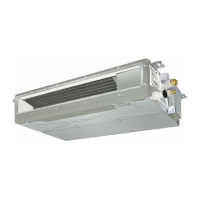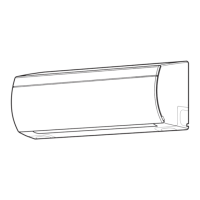Do you have a question about the Toshiba RAS-M16GDV-E and is the answer not in the manual?
Categorization of air conditioner models including concealed duct and heat pump types.
Explanation of the transition to HFC R410A for environmental protection.
Critical safety advice for air conditioner installation and grounding.
Guidelines for safe operation, avoiding hazards and handling malfunctions.
Safety instructions for moving and repairing the air conditioner unit.
Specific warnings related to installation environments and connections.
Precautions for safe usage, ventilation, and preventing damage.
Visual identification of key parts of the indoor and outdoor units.
How to operate the unit using the switch panel without the remote controller.
Procedure for configuring the unit's voltage settings.
Detailed description of each button's function on the remote.
Explanation of the icons and indicators shown on the remote control display.
Instructions for inserting and replacing batteries in the remote controller.
Guide to setting and adjusting the current time on the remote.
Factors affecting signal reception and troubleshooting transmission issues.
Steps for properly mounting the remote controller holder.
How the unit automatically selects cooling, heating, or fan mode.
Automatic mode switching based on room conditions.
Instructions for selecting cooling, heating, or fan-only modes.
Procedure for using the dehumidification (dry) mode.
Activating high power mode for rapid cooling or heating.
Procedure to turn off the high power operation.
Setting both ON and OFF timers for stop-start sequences.
Configuring combined timers for daily recurring schedules.
Saving frequently used settings using the MEMO button.
Activating saved settings with the PRESET button.
Enabling the unit to restart automatically after a power interruption.
Disabling the automatic restart feature.
How automatic and high power modes function based on conditions.
Explanation of the ECO timer's energy-saving operation.
Tips for optimizing energy efficiency and comfort.
Proper methods for cleaning the remote controller.
Steps for removing and cleaning the air return grille.
Recommended intervals and methods for cleaning air filters.
Details on 3-minute protection, power failure, and restart procedures.
How modes interact and characteristics of heating and defrosting.
Temperature and humidity ranges for optimal performance.
Instructions and precautions for installing the air conditioner.
Identifying and resolving common issues with the unit.
Troubleshooting fan speed control and mode selection problems.
Resolving problems with signal transmission, display, and receiving tones.
Categorization of air conditioner models including concealed duct and heat pump types.
Explanation of the transition to HFC R410A for environmental protection.
Critical safety advice for air conditioner installation and grounding.
Guidelines for safe operation, avoiding hazards and handling malfunctions.
Safety instructions for moving and repairing the air conditioner unit.
Specific warnings related to installation environments and connections.
Precautions for safe usage, ventilation, and preventing damage.
Visual identification of key parts of the indoor and outdoor units.
How to operate the unit using the switch panel without the remote controller.
Procedure for configuring the unit's voltage settings.
Detailed description of each button's function on the remote.
Explanation of the icons and indicators shown on the remote control display.
Instructions for inserting and replacing batteries in the remote controller.
Guide to setting and adjusting the current time on the remote.
Factors affecting signal reception and troubleshooting transmission issues.
Steps for properly mounting the remote controller holder.
How the unit automatically selects cooling, heating, or fan mode.
Automatic mode switching based on room conditions.
Instructions for selecting cooling, heating, or fan-only modes.
Procedure for using the dehumidification (dry) mode.
Activating high power mode for rapid cooling or heating.
Procedure to turn off the high power operation.
Setting both ON and OFF timers for stop-start sequences.
Configuring combined timers for daily recurring schedules.
Saving frequently used settings using the MEMO button.
Activating saved settings with the PRESET button.
Enabling the unit to restart automatically after a power interruption.
Disabling the automatic restart feature.
How automatic and high power modes function based on conditions.
Explanation of the ECO timer's energy-saving operation.
Tips for optimizing energy efficiency and comfort.
Proper methods for cleaning the remote controller.
Steps for removing and cleaning the air return grille.
Recommended intervals and methods for cleaning air filters.
Details on 3-minute protection, power failure, and restart procedures.
How modes interact and characteristics of heating and defrosting.
Temperature and humidity ranges for optimal performance.
Instructions and precautions for installing the air conditioner.
Identifying and resolving common issues with the unit.
Troubleshooting fan speed control and mode selection problems.
Resolving problems with signal transmission, display, and receiving tones.
| Cooling Capacity | 4.5 kW |
|---|---|
| Refrigerant | R32 |
| Power Supply | 220-240V, 50Hz |
| Energy Efficiency Ratio (EER) | 3.21 |
| Coefficient of Performance (COP) | 3.61 |
| Outdoor Unit Dimensions (W x H x D) | 780 x 550 x 290 mm |
| Indoor Unit Weight | 10 kg |
| Type | Split |
| Energy Efficiency Class (Cooling) | A |
| Noise Level (Indoor) | 42 dB(A) |
| Noise Level (Outdoor) | 50 dB(A) |












